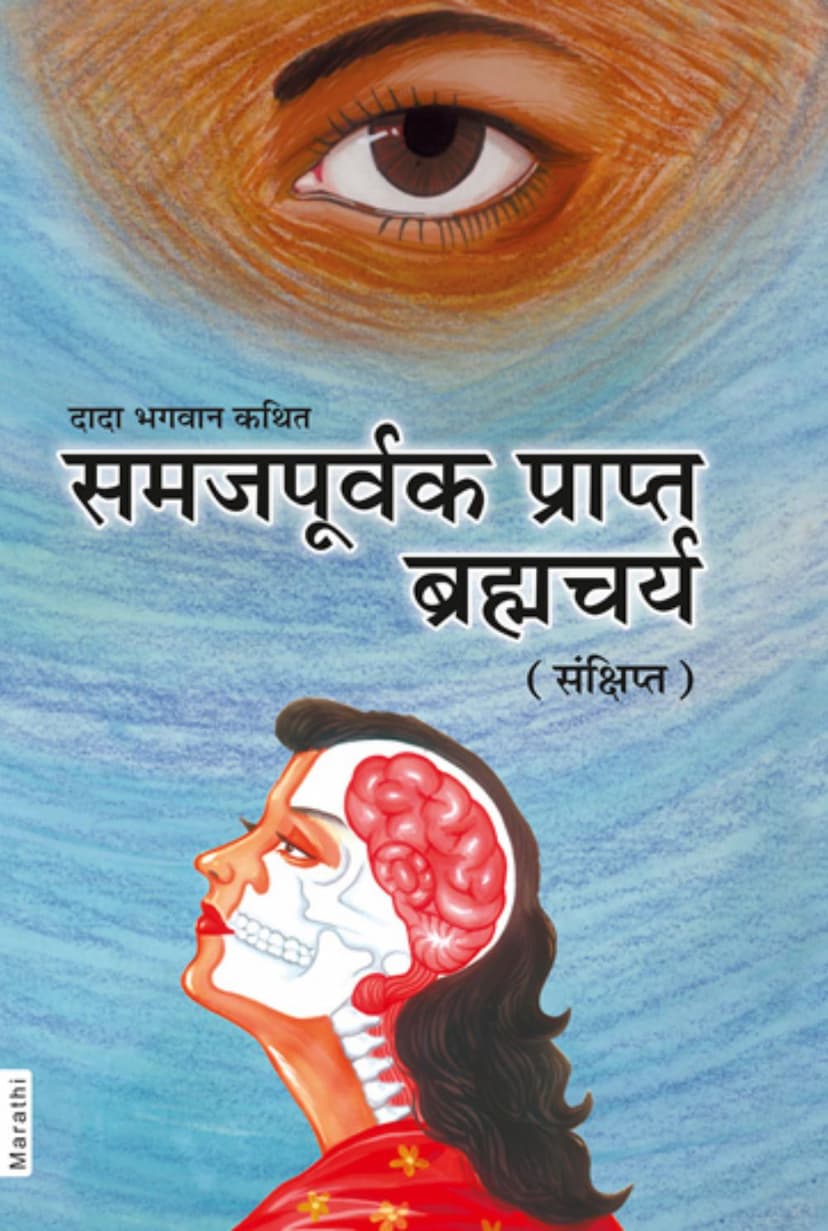Brahmcharya Sankshipt Marathi
Added to library: September 1, 2025

Summary
Here's a comprehensive summary of the Jain text "Brahmcharya Sankshipt Marathi" by Dada Bhagwan, based on the provided pages:
Book Title: Brahmcharya Sankshipt (Brief on Celibacy) Author: Dada Bhagwan (as conveyed by his teachings) Publisher: Dada Bhagwan Aradhana Trust
Overview:
This book, presented as a brief compilation of Dada Bhagwan's discourses, delves into the profound spiritual concept of Brahmacharya (celibacy or sexual abstinence) from a unique Jain perspective. It clarifies the meaning, benefits, and practical application of Brahmacharya, not just for traditional ascetics but also for householders and individuals seeking spiritual liberation in the modern world. The central theme is that true Brahmacharya is a "scientific" path to spiritual progress, achievable through correct understanding and the grace of a Gnani Purush (Self-realized being).
Key Teachings and Concepts:
- Brahmacharya as a "Scientific" Principle: The text emphasizes that Brahmacharya is not merely a moral or religious rule but a scientific principle essential for spiritual advancement. It's linked to the preservation and sublimation of "virya" (vital essence or semen), which is considered the "essence of the body" and a crucial factor for spiritual progress.
- The "Akram" (Accident-free) Path: Dada Bhagwan's teachings are presented as an "Akram" or accident-free path, contrasting with the "kramic" or step-by-step paths. This implies a shortcut or direct route to self-realization, even while living in the world.
- Understanding the Nature of "Vishay" (Sensual Objects/Experiences): A significant portion of the book focuses on dissecting the nature of sensual pleasures. Dada Bhagwan repeatedly stresses that sensual experiences are inherently impure, like "garbage" or "discharges" from the body. The attraction to them stems from ignorance ("agnan") and incorrect beliefs ("rong bīlīf").
- "Three Vision" for Discerning Reality: The text introduces the concept of "Three Vision" (Trividya Drishti) as a tool to overcome attachment to sensual objects. This involves seeing the body not just as it appears externally but also through its layers of skin, flesh, blood, and internal organs, revealing its ultimately impure nature. This practice helps to cultivate detachment and "vairagya" (renunciation).
- The Importance of "Nischay" (Determination) and "Pratikraman" (Self-Repentance): A strong determination to remain celibate, coupled with consistent "pratikraman" (confessing one's faults and seeking forgiveness), is highlighted as essential for overcoming sensual urges. The book provides practical guidance on how to perform pratikraman.
- Brahmacharya for Householders: The book offers a nuanced perspective on Brahmacharya for married individuals. It suggests that while complete celibacy might be difficult for householders, maintaining fidelity to one's spouse and avoiding attraction towards others is considered a form of Brahmacharya in the current era. The key is to manage worldly interactions with awareness and without harboring sensual thoughts.
- The Role of a Gnani Purush: The guidance and blessings of a Gnani Purush are presented as crucial for achieving true Brahmacharya and spiritual liberation. The Gnani's teachings and presence help in dissolving ignorance and providing the strength to overcome sensual desires.
- "Bhav Brahmacharya" (Internal Celibacy): The ultimate goal is not just external restraint but "bhav brahmacharya," where sensual thoughts and desires cease to arise. This is achieved through self-knowledge and the realization of the pure soul.
- "Galan" (Discharge) vs. "Urdhvagaman" (Upward Flow): The book discusses the concept of "galan," which refers to the discharge of semen, and "urdhvagaman," the upward flow of vital energy. True Brahmacharya leads to the upward flow, which strengthens spiritual potential, while uncontrolled discharge weakens it.
- Consequences of "Abrahmacharya" (Lack of Celibacy): The text warns against the negative consequences of sensual indulgence, including physical weakness, mental disturbances, and the perpetuation of the cycle of birth and death. It equates uncontrolled sensual behavior with "pashavta" (animalistic behavior).
- The Significance of "Sanyam" (Self-Control) and "Tyag" (Renunciation): While the "Akram" path emphasizes understanding, self-control and renunciation are still considered important tools, especially when internal resolution wavers.
- The Importance of "Satsang" (Association with the Wise): Regular attendance at spiritual discourses and association with like-minded individuals ("brahmachariyunno samuh") is recommended for strengthening resolve and maintaining spiritual momentum.
Structure and Content:
The book is organized into sections that address Brahmacharya from various angles, including:
- Analysis of sensual desires: Understanding the root causes and nature of sensual attractions.
- The path to freedom from desires: Strategies and perspectives to overcome sensual urges.
- The glory of Brahmacharya: The benefits and spiritual significance of practicing Brahmacharya.
- Guidance for those who decide not to marry: Practical advice for individuals committed to lifelong celibacy.
- The key to Brahmacharya for the married: How to navigate married life while progressing spiritually.
- The risks of distorted perception: Understanding the illusions that lead to sensual attachment.
- The sin of unlawful enjoyment: The severe consequences of engaging in extramarital or forbidden sensual activities.
- One-woman fidelity as Brahmacharya: Redefining Brahmacharya for married individuals.
- The science of attraction and repulsion: Understanding the energetic principles behind desire.
Overall Message:
"Brahmcharya Sankshipt" offers a practical and insightful guide to understanding and practicing Brahmacharya as a means to achieve spiritual purity and self-realization. It emphasizes that through correct knowledge, unwavering determination, and the grace of a Gnani Purush, liberation from sensual desires and the cycle of rebirth is possible, even while living in the midst of worldly responsibilities. The book aims to dispel misconceptions and provide a clear, scientific path towards this profound spiritual state.